Project Management Challenges and Solutions
VerifiedAdded on 2020/04/07
|15
|4802
|52
AI Summary
This assignment delves into the complexities of project management, particularly when dealing with larger projects. It examines various challenges faced during such endeavors, including managing stakeholder expectations, effectively communicating within teams, and ensuring timely project completion. The assignment encourages students to analyze these challenges and propose practical solutions based on established project management principles and methodologies.
Contribute Materials
Your contribution can guide someone’s learning journey. Share your
documents today.

Course Title
[Write Course Name Here]
By: [Write your full name here]
UK Public College
Date Submitted:
[dd-mmm-yyyy]
[Write Course Name Here]
By: [Write your full name here]
UK Public College
Date Submitted:
[dd-mmm-yyyy]
Secure Best Marks with AI Grader
Need help grading? Try our AI Grader for instant feedback on your assignments.
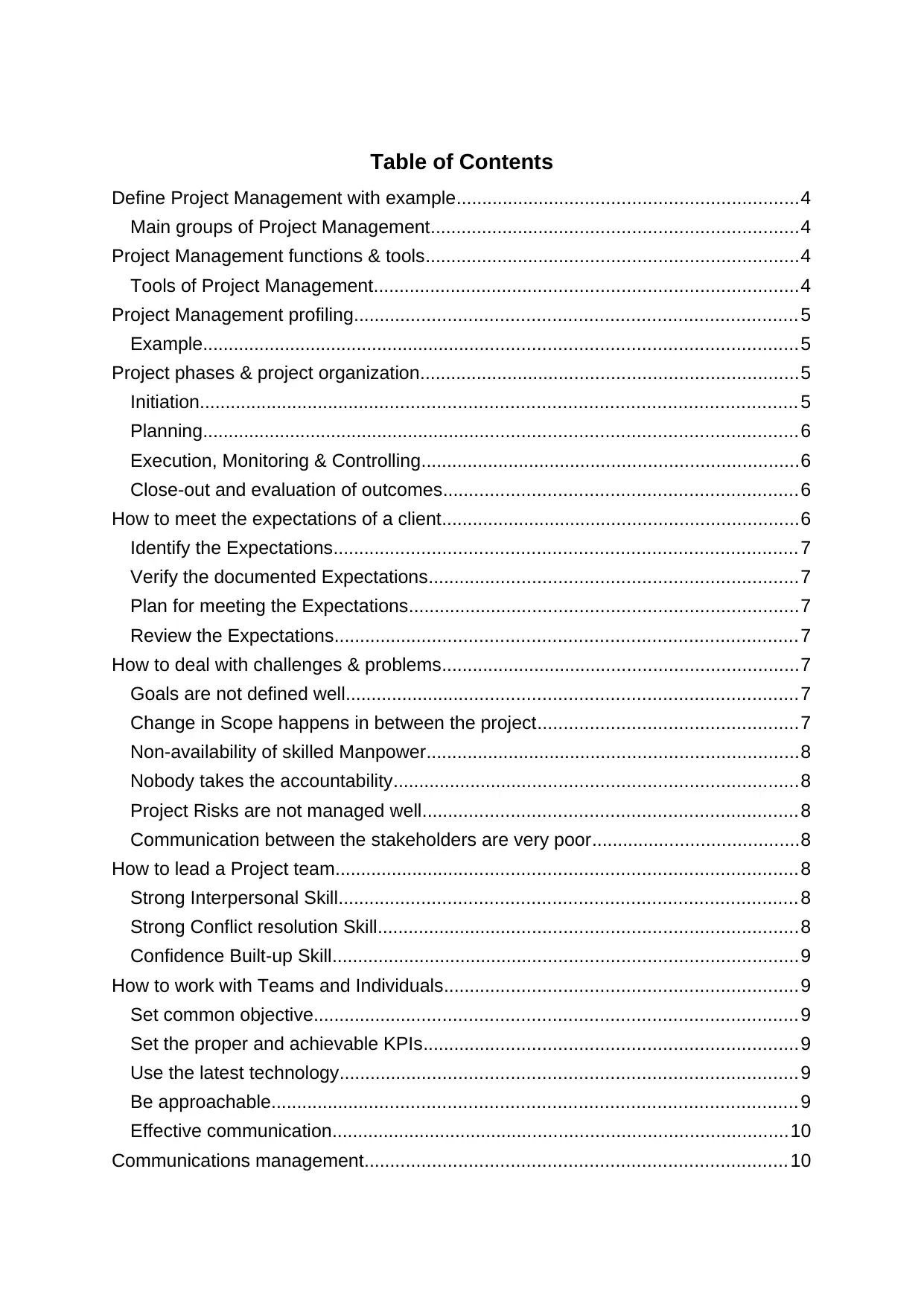
Table of Contents
Define Project Management with example..................................................................4
Main groups of Project Management.......................................................................4
Project Management functions & tools........................................................................4
Tools of Project Management..................................................................................4
Project Management profiling..................................................................................... 5
Example...................................................................................................................5
Project phases & project organization.........................................................................5
Initiation................................................................................................................... 5
Planning...................................................................................................................6
Execution, Monitoring & Controlling.........................................................................6
Close-out and evaluation of outcomes....................................................................6
How to meet the expectations of a client.....................................................................6
Identify the Expectations.........................................................................................7
Verify the documented Expectations.......................................................................7
Plan for meeting the Expectations...........................................................................7
Review the Expectations.........................................................................................7
How to deal with challenges & problems.....................................................................7
Goals are not defined well.......................................................................................7
Change in Scope happens in between the project..................................................7
Non-availability of skilled Manpower........................................................................8
Nobody takes the accountability..............................................................................8
Project Risks are not managed well........................................................................8
Communication between the stakeholders are very poor........................................8
How to lead a Project team.........................................................................................8
Strong Interpersonal Skill........................................................................................ 8
Strong Conflict resolution Skill.................................................................................8
Confidence Built-up Skill..........................................................................................9
How to work with Teams and Individuals....................................................................9
Set common objective.............................................................................................9
Set the proper and achievable KPIs........................................................................9
Use the latest technology........................................................................................9
Be approachable..................................................................................................... 9
Effective communication........................................................................................10
Communications management................................................................................. 10
Define Project Management with example..................................................................4
Main groups of Project Management.......................................................................4
Project Management functions & tools........................................................................4
Tools of Project Management..................................................................................4
Project Management profiling..................................................................................... 5
Example...................................................................................................................5
Project phases & project organization.........................................................................5
Initiation................................................................................................................... 5
Planning...................................................................................................................6
Execution, Monitoring & Controlling.........................................................................6
Close-out and evaluation of outcomes....................................................................6
How to meet the expectations of a client.....................................................................6
Identify the Expectations.........................................................................................7
Verify the documented Expectations.......................................................................7
Plan for meeting the Expectations...........................................................................7
Review the Expectations.........................................................................................7
How to deal with challenges & problems.....................................................................7
Goals are not defined well.......................................................................................7
Change in Scope happens in between the project..................................................7
Non-availability of skilled Manpower........................................................................8
Nobody takes the accountability..............................................................................8
Project Risks are not managed well........................................................................8
Communication between the stakeholders are very poor........................................8
How to lead a Project team.........................................................................................8
Strong Interpersonal Skill........................................................................................ 8
Strong Conflict resolution Skill.................................................................................8
Confidence Built-up Skill..........................................................................................9
How to work with Teams and Individuals....................................................................9
Set common objective.............................................................................................9
Set the proper and achievable KPIs........................................................................9
Use the latest technology........................................................................................9
Be approachable..................................................................................................... 9
Effective communication........................................................................................10
Communications management................................................................................. 10
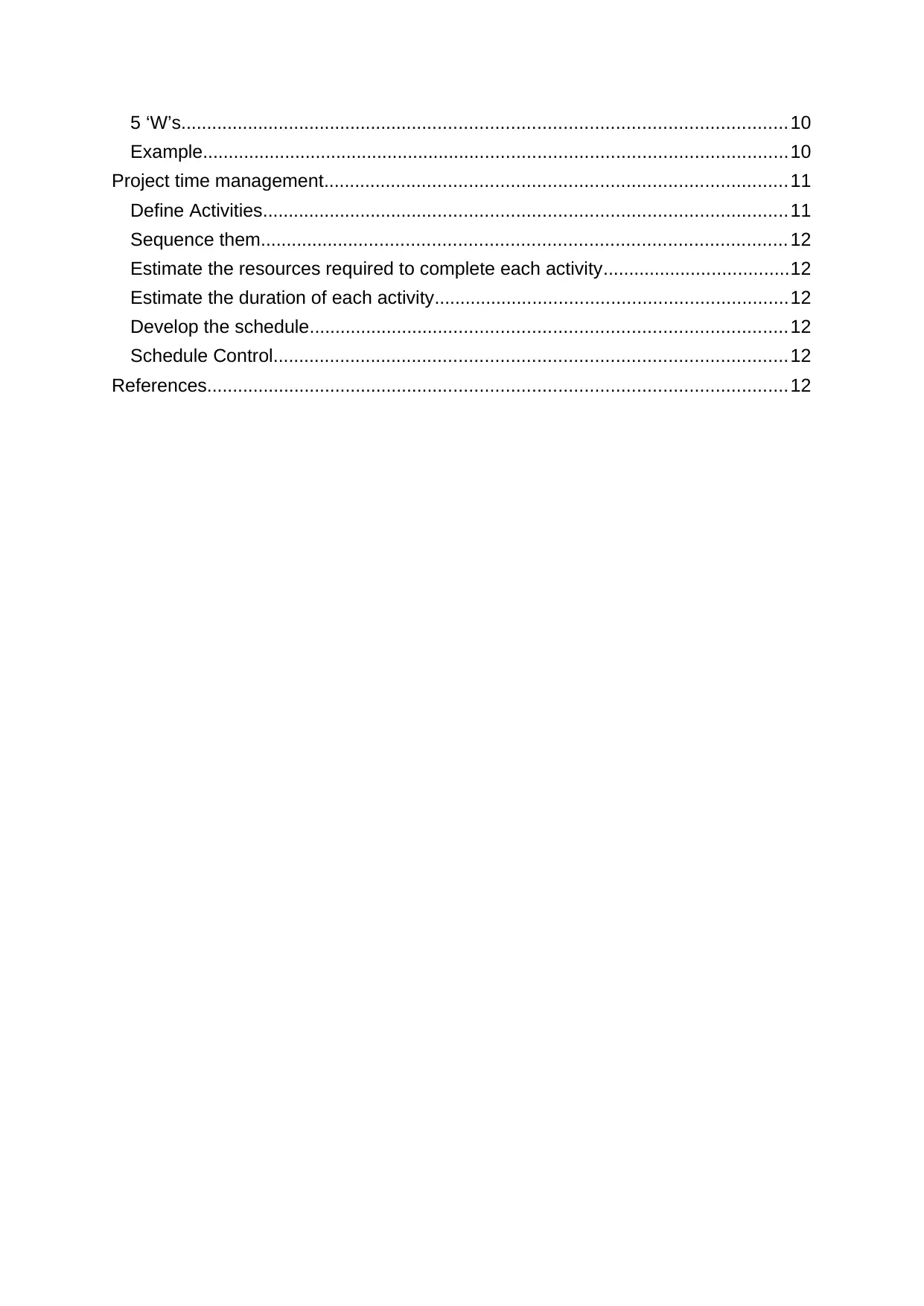
5 ‘W’s.....................................................................................................................10
Example.................................................................................................................10
Project time management.........................................................................................11
Define Activities.....................................................................................................11
Sequence them..................................................................................................... 12
Estimate the resources required to complete each activity....................................12
Estimate the duration of each activity....................................................................12
Develop the schedule............................................................................................12
Schedule Control...................................................................................................12
References................................................................................................................12
Example.................................................................................................................10
Project time management.........................................................................................11
Define Activities.....................................................................................................11
Sequence them..................................................................................................... 12
Estimate the resources required to complete each activity....................................12
Estimate the duration of each activity....................................................................12
Develop the schedule............................................................................................12
Schedule Control...................................................................................................12
References................................................................................................................12
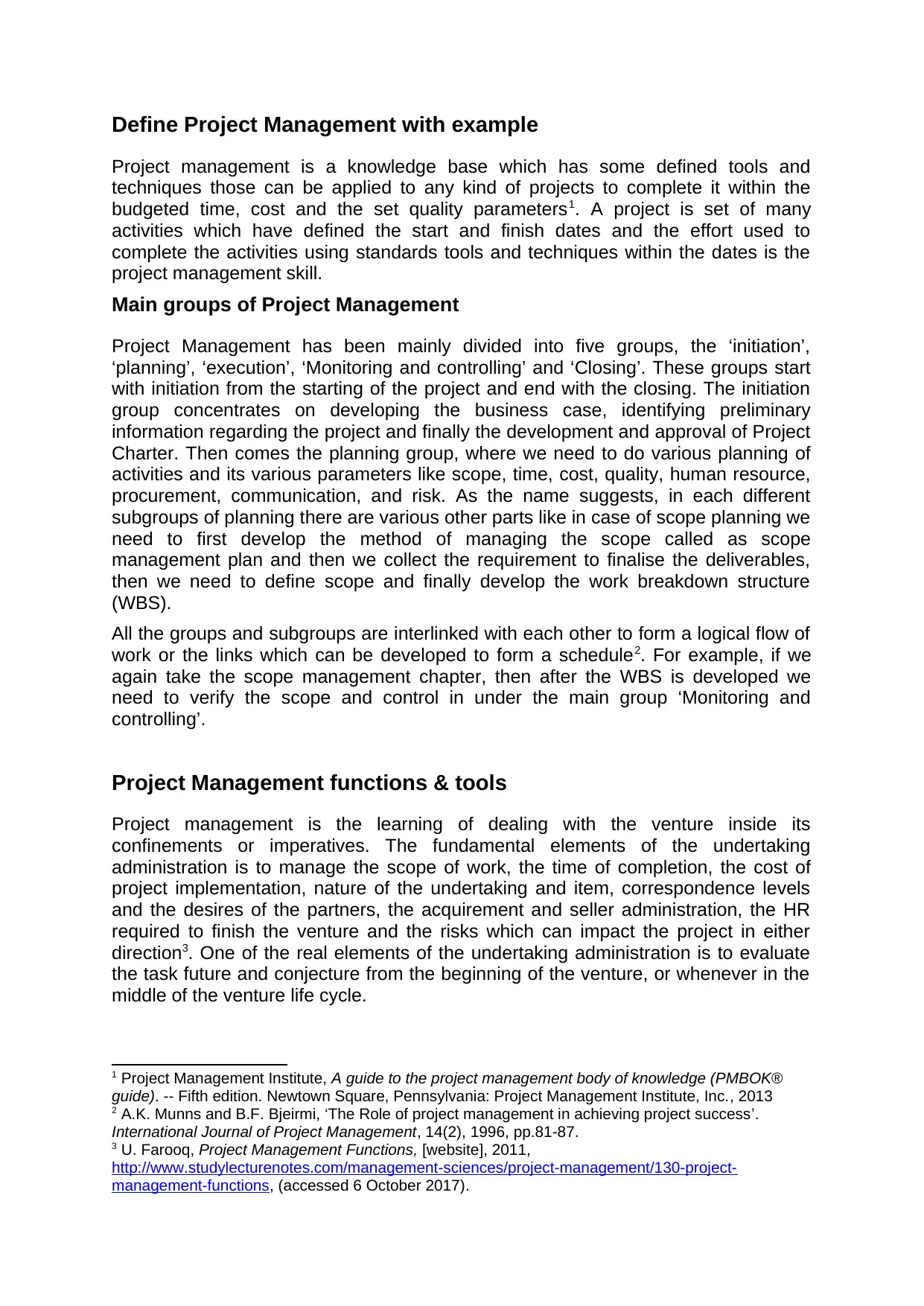
Define Project Management with example
Project management is a knowledge base which has some defined tools and
techniques those can be applied to any kind of projects to complete it within the
budgeted time, cost and the set quality parameters1. A project is set of many
activities which have defined the start and finish dates and the effort used to
complete the activities using standards tools and techniques within the dates is the
project management skill.
Main groups of Project Management
Project Management has been mainly divided into five groups, the ‘initiation’,
‘planning’, ‘execution’, ‘Monitoring and controlling’ and ‘Closing’. These groups start
with initiation from the starting of the project and end with the closing. The initiation
group concentrates on developing the business case, identifying preliminary
information regarding the project and finally the development and approval of Project
Charter. Then comes the planning group, where we need to do various planning of
activities and its various parameters like scope, time, cost, quality, human resource,
procurement, communication, and risk. As the name suggests, in each different
subgroups of planning there are various other parts like in case of scope planning we
need to first develop the method of managing the scope called as scope
management plan and then we collect the requirement to finalise the deliverables,
then we need to define scope and finally develop the work breakdown structure
(WBS).
All the groups and subgroups are interlinked with each other to form a logical flow of
work or the links which can be developed to form a schedule2. For example, if we
again take the scope management chapter, then after the WBS is developed we
need to verify the scope and control in under the main group ‘Monitoring and
controlling’.
Project Management functions & tools
Project management is the learning of dealing with the venture inside its
confinements or imperatives. The fundamental elements of the undertaking
administration is to manage the scope of work, the time of completion, the cost of
project implementation, nature of the undertaking and item, correspondence levels
and the desires of the partners, the acquirement and seller administration, the HR
required to finish the venture and the risks which can impact the project in either
direction3. One of the real elements of the undertaking administration is to evaluate
the task future and conjecture from the beginning of the venture, or whenever in the
middle of the venture life cycle.
1 Project Management Institute, A guide to the project management body of knowledge (PMBOK®
guide). -- Fifth edition. Newtown Square, Pennsylvania: Project Management Institute, Inc., 2013
2 A.K. Munns and B.F. Bjeirmi, ‘The Role of project management in achieving project success’.
International Journal of Project Management, 14(2), 1996, pp.81-87.
3 U. Farooq, Project Management Functions, [website], 2011,
http://www.studylecturenotes.com/management-sciences/project-management/130-project-
management-functions, (accessed 6 October 2017).
Project management is a knowledge base which has some defined tools and
techniques those can be applied to any kind of projects to complete it within the
budgeted time, cost and the set quality parameters1. A project is set of many
activities which have defined the start and finish dates and the effort used to
complete the activities using standards tools and techniques within the dates is the
project management skill.
Main groups of Project Management
Project Management has been mainly divided into five groups, the ‘initiation’,
‘planning’, ‘execution’, ‘Monitoring and controlling’ and ‘Closing’. These groups start
with initiation from the starting of the project and end with the closing. The initiation
group concentrates on developing the business case, identifying preliminary
information regarding the project and finally the development and approval of Project
Charter. Then comes the planning group, where we need to do various planning of
activities and its various parameters like scope, time, cost, quality, human resource,
procurement, communication, and risk. As the name suggests, in each different
subgroups of planning there are various other parts like in case of scope planning we
need to first develop the method of managing the scope called as scope
management plan and then we collect the requirement to finalise the deliverables,
then we need to define scope and finally develop the work breakdown structure
(WBS).
All the groups and subgroups are interlinked with each other to form a logical flow of
work or the links which can be developed to form a schedule2. For example, if we
again take the scope management chapter, then after the WBS is developed we
need to verify the scope and control in under the main group ‘Monitoring and
controlling’.
Project Management functions & tools
Project management is the learning of dealing with the venture inside its
confinements or imperatives. The fundamental elements of the undertaking
administration is to manage the scope of work, the time of completion, the cost of
project implementation, nature of the undertaking and item, correspondence levels
and the desires of the partners, the acquirement and seller administration, the HR
required to finish the venture and the risks which can impact the project in either
direction3. One of the real elements of the undertaking administration is to evaluate
the task future and conjecture from the beginning of the venture, or whenever in the
middle of the venture life cycle.
1 Project Management Institute, A guide to the project management body of knowledge (PMBOK®
guide). -- Fifth edition. Newtown Square, Pennsylvania: Project Management Institute, Inc., 2013
2 A.K. Munns and B.F. Bjeirmi, ‘The Role of project management in achieving project success’.
International Journal of Project Management, 14(2), 1996, pp.81-87.
3 U. Farooq, Project Management Functions, [website], 2011,
http://www.studylecturenotes.com/management-sciences/project-management/130-project-
management-functions, (accessed 6 October 2017).
Secure Best Marks with AI Grader
Need help grading? Try our AI Grader for instant feedback on your assignments.
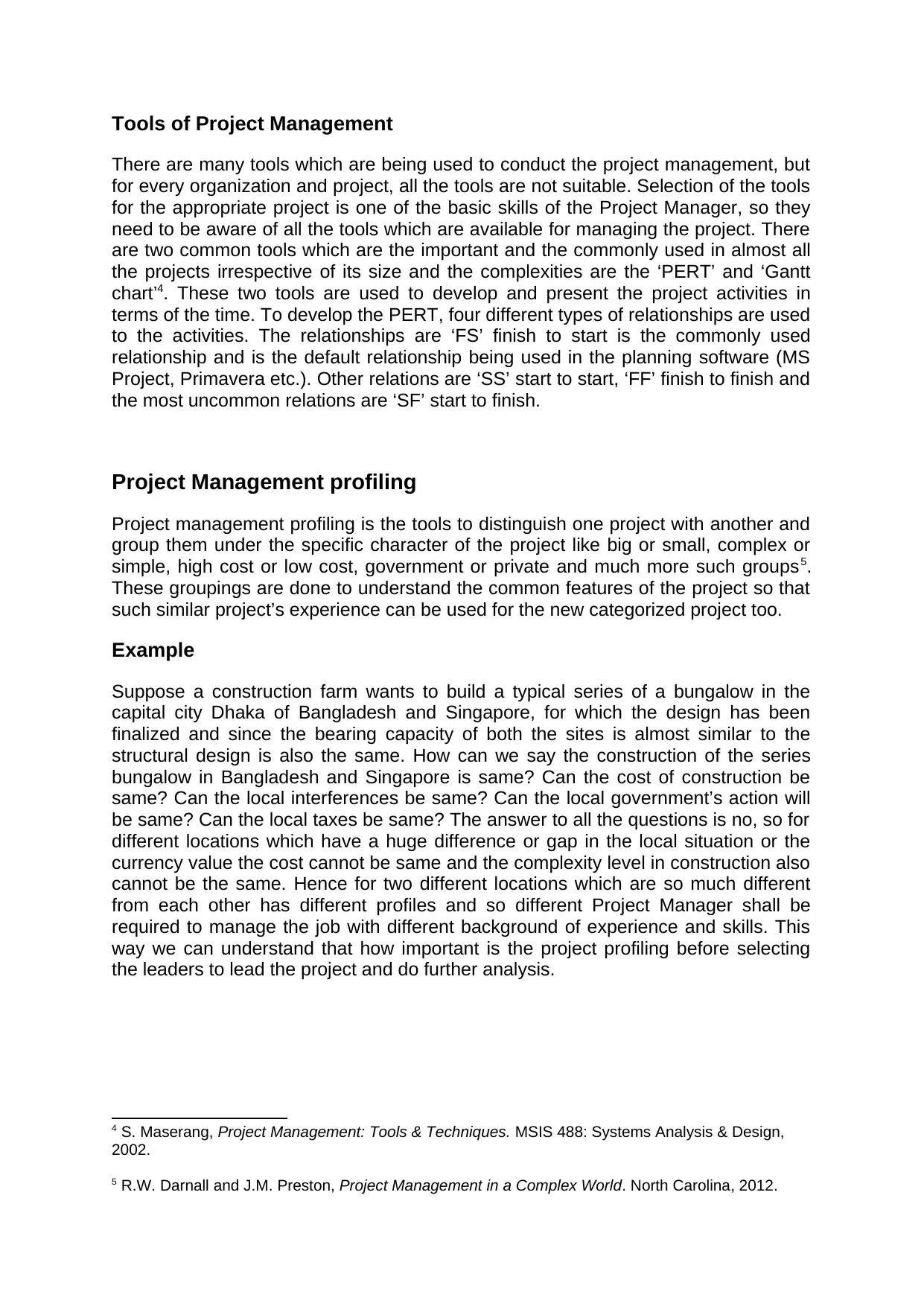
Tools of Project Management
There are many tools which are being used to conduct the project management, but
for every organization and project, all the tools are not suitable. Selection of the tools
for the appropriate project is one of the basic skills of the Project Manager, so they
need to be aware of all the tools which are available for managing the project. There
are two common tools which are the important and the commonly used in almost all
the projects irrespective of its size and the complexities are the ‘PERT’ and ‘Gantt
chart’4. These two tools are used to develop and present the project activities in
terms of the time. To develop the PERT, four different types of relationships are used
to the activities. The relationships are ‘FS’ finish to start is the commonly used
relationship and is the default relationship being used in the planning software (MS
Project, Primavera etc.). Other relations are ‘SS’ start to start, ‘FF’ finish to finish and
the most uncommon relations are ‘SF’ start to finish.
Project Management profiling
Project management profiling is the tools to distinguish one project with another and
group them under the specific character of the project like big or small, complex or
simple, high cost or low cost, government or private and much more such groups5.
These groupings are done to understand the common features of the project so that
such similar project’s experience can be used for the new categorized project too.
Example
Suppose a construction farm wants to build a typical series of a bungalow in the
capital city Dhaka of Bangladesh and Singapore, for which the design has been
finalized and since the bearing capacity of both the sites is almost similar to the
structural design is also the same. How can we say the construction of the series
bungalow in Bangladesh and Singapore is same? Can the cost of construction be
same? Can the local interferences be same? Can the local government’s action will
be same? Can the local taxes be same? The answer to all the questions is no, so for
different locations which have a huge difference or gap in the local situation or the
currency value the cost cannot be same and the complexity level in construction also
cannot be the same. Hence for two different locations which are so much different
from each other has different profiles and so different Project Manager shall be
required to manage the job with different background of experience and skills. This
way we can understand that how important is the project profiling before selecting
the leaders to lead the project and do further analysis.
4 S. Maserang, Project Management: Tools & Techniques. MSIS 488: Systems Analysis & Design,
2002.
5 R.W. Darnall and J.M. Preston, Project Management in a Complex World. North Carolina, 2012.
There are many tools which are being used to conduct the project management, but
for every organization and project, all the tools are not suitable. Selection of the tools
for the appropriate project is one of the basic skills of the Project Manager, so they
need to be aware of all the tools which are available for managing the project. There
are two common tools which are the important and the commonly used in almost all
the projects irrespective of its size and the complexities are the ‘PERT’ and ‘Gantt
chart’4. These two tools are used to develop and present the project activities in
terms of the time. To develop the PERT, four different types of relationships are used
to the activities. The relationships are ‘FS’ finish to start is the commonly used
relationship and is the default relationship being used in the planning software (MS
Project, Primavera etc.). Other relations are ‘SS’ start to start, ‘FF’ finish to finish and
the most uncommon relations are ‘SF’ start to finish.
Project Management profiling
Project management profiling is the tools to distinguish one project with another and
group them under the specific character of the project like big or small, complex or
simple, high cost or low cost, government or private and much more such groups5.
These groupings are done to understand the common features of the project so that
such similar project’s experience can be used for the new categorized project too.
Example
Suppose a construction farm wants to build a typical series of a bungalow in the
capital city Dhaka of Bangladesh and Singapore, for which the design has been
finalized and since the bearing capacity of both the sites is almost similar to the
structural design is also the same. How can we say the construction of the series
bungalow in Bangladesh and Singapore is same? Can the cost of construction be
same? Can the local interferences be same? Can the local government’s action will
be same? Can the local taxes be same? The answer to all the questions is no, so for
different locations which have a huge difference or gap in the local situation or the
currency value the cost cannot be same and the complexity level in construction also
cannot be the same. Hence for two different locations which are so much different
from each other has different profiles and so different Project Manager shall be
required to manage the job with different background of experience and skills. This
way we can understand that how important is the project profiling before selecting
the leaders to lead the project and do further analysis.
4 S. Maserang, Project Management: Tools & Techniques. MSIS 488: Systems Analysis & Design,
2002.
5 R.W. Darnall and J.M. Preston, Project Management in a Complex World. North Carolina, 2012.
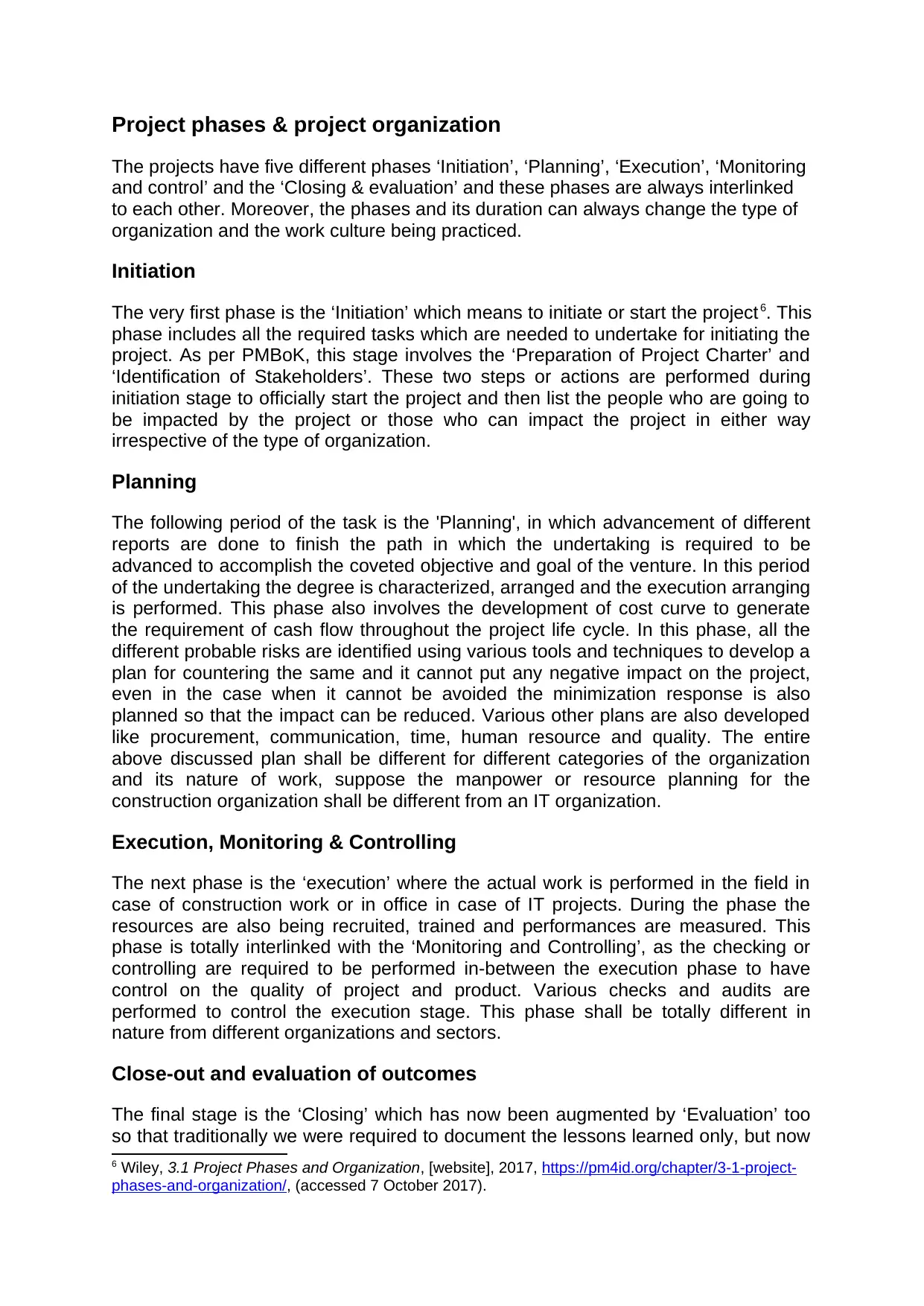
Project phases & project organization
The projects have five different phases ‘Initiation’, ‘Planning’, ‘Execution’, ‘Monitoring
and control’ and the ‘Closing & evaluation’ and these phases are always interlinked
to each other. Moreover, the phases and its duration can always change the type of
organization and the work culture being practiced.
Initiation
The very first phase is the ‘Initiation’ which means to initiate or start the project6. This
phase includes all the required tasks which are needed to undertake for initiating the
project. As per PMBoK, this stage involves the ‘Preparation of Project Charter’ and
‘Identification of Stakeholders’. These two steps or actions are performed during
initiation stage to officially start the project and then list the people who are going to
be impacted by the project or those who can impact the project in either way
irrespective of the type of organization.
Planning
The following period of the task is the 'Planning', in which advancement of different
reports are done to finish the path in which the undertaking is required to be
advanced to accomplish the coveted objective and goal of the venture. In this period
of the undertaking the degree is characterized, arranged and the execution arranging
is performed. This phase also involves the development of cost curve to generate
the requirement of cash flow throughout the project life cycle. In this phase, all the
different probable risks are identified using various tools and techniques to develop a
plan for countering the same and it cannot put any negative impact on the project,
even in the case when it cannot be avoided the minimization response is also
planned so that the impact can be reduced. Various other plans are also developed
like procurement, communication, time, human resource and quality. The entire
above discussed plan shall be different for different categories of the organization
and its nature of work, suppose the manpower or resource planning for the
construction organization shall be different from an IT organization.
Execution, Monitoring & Controlling
The next phase is the ‘execution’ where the actual work is performed in the field in
case of construction work or in office in case of IT projects. During the phase the
resources are also being recruited, trained and performances are measured. This
phase is totally interlinked with the ‘Monitoring and Controlling’, as the checking or
controlling are required to be performed in-between the execution phase to have
control on the quality of project and product. Various checks and audits are
performed to control the execution stage. This phase shall be totally different in
nature from different organizations and sectors.
Close-out and evaluation of outcomes
The final stage is the ‘Closing’ which has now been augmented by ‘Evaluation’ too
so that traditionally we were required to document the lessons learned only, but now
6 Wiley, 3.1 Project Phases and Organization, [website], 2017, https://pm4id.org/chapter/3-1-project-
phases-and-organization/, (accessed 7 October 2017).
The projects have five different phases ‘Initiation’, ‘Planning’, ‘Execution’, ‘Monitoring
and control’ and the ‘Closing & evaluation’ and these phases are always interlinked
to each other. Moreover, the phases and its duration can always change the type of
organization and the work culture being practiced.
Initiation
The very first phase is the ‘Initiation’ which means to initiate or start the project6. This
phase includes all the required tasks which are needed to undertake for initiating the
project. As per PMBoK, this stage involves the ‘Preparation of Project Charter’ and
‘Identification of Stakeholders’. These two steps or actions are performed during
initiation stage to officially start the project and then list the people who are going to
be impacted by the project or those who can impact the project in either way
irrespective of the type of organization.
Planning
The following period of the task is the 'Planning', in which advancement of different
reports are done to finish the path in which the undertaking is required to be
advanced to accomplish the coveted objective and goal of the venture. In this period
of the undertaking the degree is characterized, arranged and the execution arranging
is performed. This phase also involves the development of cost curve to generate
the requirement of cash flow throughout the project life cycle. In this phase, all the
different probable risks are identified using various tools and techniques to develop a
plan for countering the same and it cannot put any negative impact on the project,
even in the case when it cannot be avoided the minimization response is also
planned so that the impact can be reduced. Various other plans are also developed
like procurement, communication, time, human resource and quality. The entire
above discussed plan shall be different for different categories of the organization
and its nature of work, suppose the manpower or resource planning for the
construction organization shall be different from an IT organization.
Execution, Monitoring & Controlling
The next phase is the ‘execution’ where the actual work is performed in the field in
case of construction work or in office in case of IT projects. During the phase the
resources are also being recruited, trained and performances are measured. This
phase is totally interlinked with the ‘Monitoring and Controlling’, as the checking or
controlling are required to be performed in-between the execution phase to have
control on the quality of project and product. Various checks and audits are
performed to control the execution stage. This phase shall be totally different in
nature from different organizations and sectors.
Close-out and evaluation of outcomes
The final stage is the ‘Closing’ which has now been augmented by ‘Evaluation’ too
so that traditionally we were required to document the lessons learned only, but now
6 Wiley, 3.1 Project Phases and Organization, [website], 2017, https://pm4id.org/chapter/3-1-project-
phases-and-organization/, (accessed 7 October 2017).
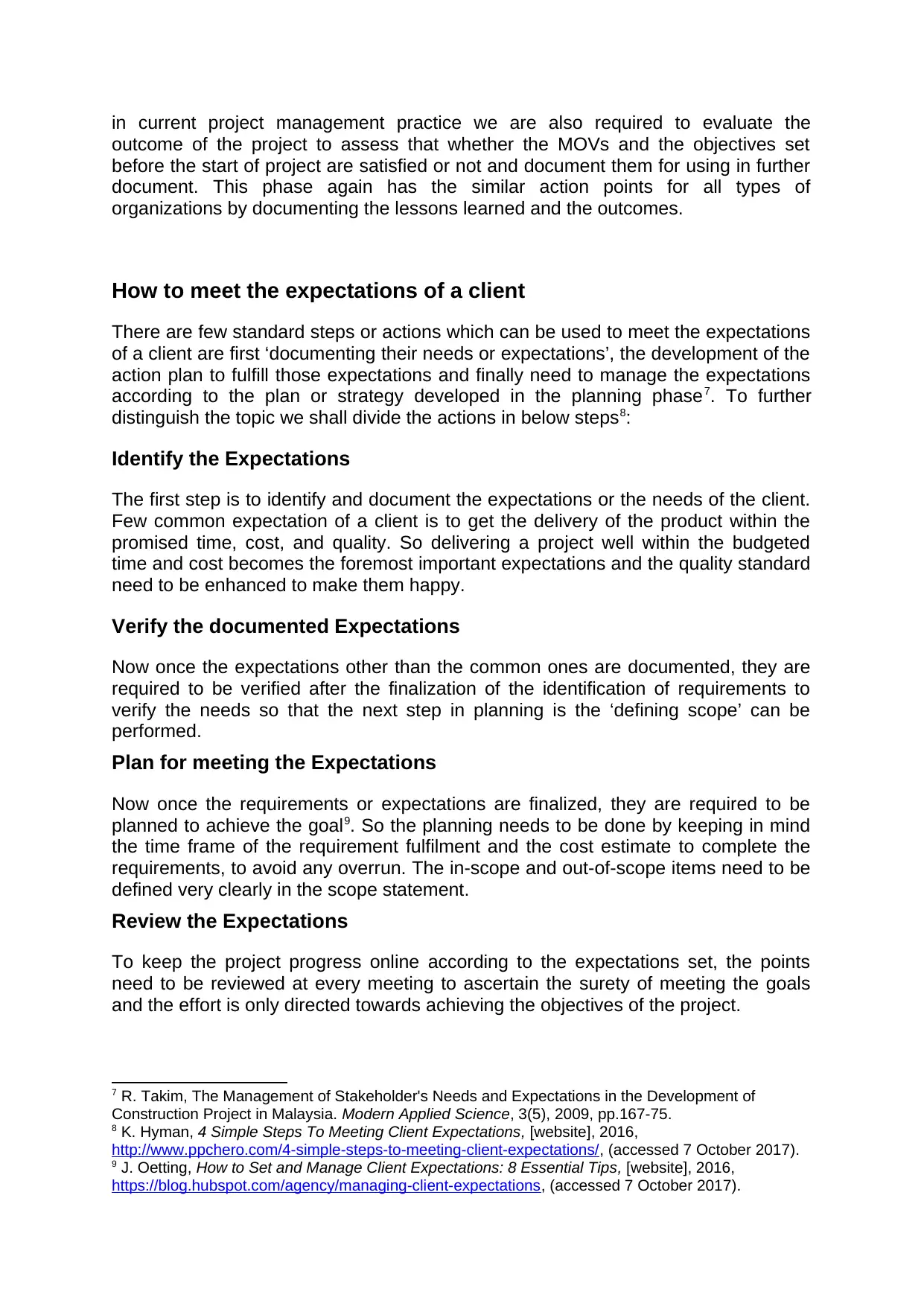
in current project management practice we are also required to evaluate the
outcome of the project to assess that whether the MOVs and the objectives set
before the start of project are satisfied or not and document them for using in further
document. This phase again has the similar action points for all types of
organizations by documenting the lessons learned and the outcomes.
How to meet the expectations of a client
There are few standard steps or actions which can be used to meet the expectations
of a client are first ‘documenting their needs or expectations’, the development of the
action plan to fulfill those expectations and finally need to manage the expectations
according to the plan or strategy developed in the planning phase7. To further
distinguish the topic we shall divide the actions in below steps8:
Identify the Expectations
The first step is to identify and document the expectations or the needs of the client.
Few common expectation of a client is to get the delivery of the product within the
promised time, cost, and quality. So delivering a project well within the budgeted
time and cost becomes the foremost important expectations and the quality standard
need to be enhanced to make them happy.
Verify the documented Expectations
Now once the expectations other than the common ones are documented, they are
required to be verified after the finalization of the identification of requirements to
verify the needs so that the next step in planning is the ‘defining scope’ can be
performed.
Plan for meeting the Expectations
Now once the requirements or expectations are finalized, they are required to be
planned to achieve the goal9. So the planning needs to be done by keeping in mind
the time frame of the requirement fulfilment and the cost estimate to complete the
requirements, to avoid any overrun. The in-scope and out-of-scope items need to be
defined very clearly in the scope statement.
Review the Expectations
To keep the project progress online according to the expectations set, the points
need to be reviewed at every meeting to ascertain the surety of meeting the goals
and the effort is only directed towards achieving the objectives of the project.
7 R. Takim, The Management of Stakeholder's Needs and Expectations in the Development of
Construction Project in Malaysia. Modern Applied Science, 3(5), 2009, pp.167-75.
8 K. Hyman, 4 Simple Steps To Meeting Client Expectations, [website], 2016,
http://www.ppchero.com/4-simple-steps-to-meeting-client-expectations/, (accessed 7 October 2017).
9 J. Oetting, How to Set and Manage Client Expectations: 8 Essential Tips, [website], 2016,
https://blog.hubspot.com/agency/managing-client-expectations, (accessed 7 October 2017).
outcome of the project to assess that whether the MOVs and the objectives set
before the start of project are satisfied or not and document them for using in further
document. This phase again has the similar action points for all types of
organizations by documenting the lessons learned and the outcomes.
How to meet the expectations of a client
There are few standard steps or actions which can be used to meet the expectations
of a client are first ‘documenting their needs or expectations’, the development of the
action plan to fulfill those expectations and finally need to manage the expectations
according to the plan or strategy developed in the planning phase7. To further
distinguish the topic we shall divide the actions in below steps8:
Identify the Expectations
The first step is to identify and document the expectations or the needs of the client.
Few common expectation of a client is to get the delivery of the product within the
promised time, cost, and quality. So delivering a project well within the budgeted
time and cost becomes the foremost important expectations and the quality standard
need to be enhanced to make them happy.
Verify the documented Expectations
Now once the expectations other than the common ones are documented, they are
required to be verified after the finalization of the identification of requirements to
verify the needs so that the next step in planning is the ‘defining scope’ can be
performed.
Plan for meeting the Expectations
Now once the requirements or expectations are finalized, they are required to be
planned to achieve the goal9. So the planning needs to be done by keeping in mind
the time frame of the requirement fulfilment and the cost estimate to complete the
requirements, to avoid any overrun. The in-scope and out-of-scope items need to be
defined very clearly in the scope statement.
Review the Expectations
To keep the project progress online according to the expectations set, the points
need to be reviewed at every meeting to ascertain the surety of meeting the goals
and the effort is only directed towards achieving the objectives of the project.
7 R. Takim, The Management of Stakeholder's Needs and Expectations in the Development of
Construction Project in Malaysia. Modern Applied Science, 3(5), 2009, pp.167-75.
8 K. Hyman, 4 Simple Steps To Meeting Client Expectations, [website], 2016,
http://www.ppchero.com/4-simple-steps-to-meeting-client-expectations/, (accessed 7 October 2017).
9 J. Oetting, How to Set and Manage Client Expectations: 8 Essential Tips, [website], 2016,
https://blog.hubspot.com/agency/managing-client-expectations, (accessed 7 October 2017).
Paraphrase This Document
Need a fresh take? Get an instant paraphrase of this document with our AI Paraphraser
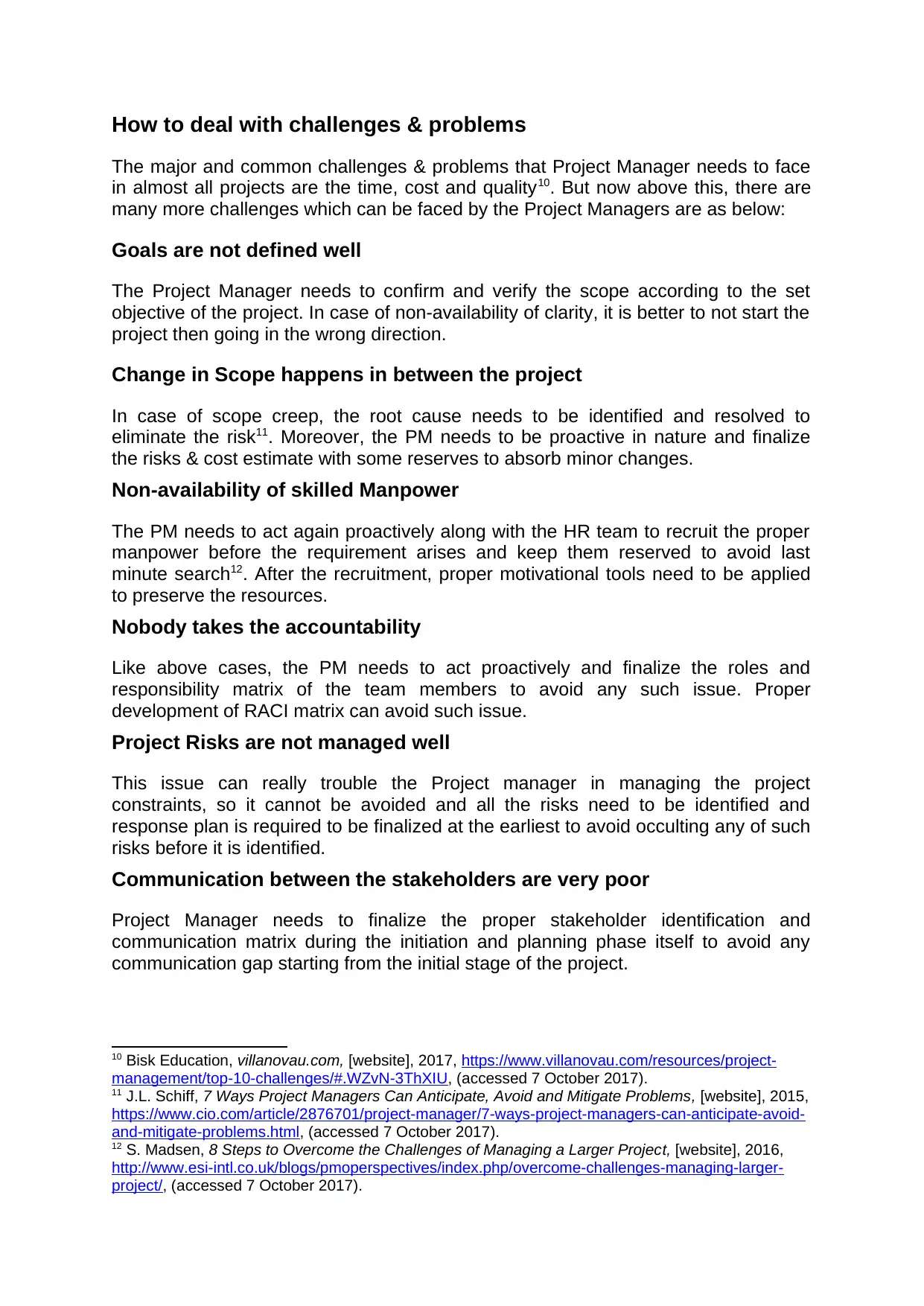
How to deal with challenges & problems
The major and common challenges & problems that Project Manager needs to face
in almost all projects are the time, cost and quality10. But now above this, there are
many more challenges which can be faced by the Project Managers are as below:
Goals are not defined well
The Project Manager needs to confirm and verify the scope according to the set
objective of the project. In case of non-availability of clarity, it is better to not start the
project then going in the wrong direction.
Change in Scope happens in between the project
In case of scope creep, the root cause needs to be identified and resolved to
eliminate the risk11. Moreover, the PM needs to be proactive in nature and finalize
the risks & cost estimate with some reserves to absorb minor changes.
Non-availability of skilled Manpower
The PM needs to act again proactively along with the HR team to recruit the proper
manpower before the requirement arises and keep them reserved to avoid last
minute search12. After the recruitment, proper motivational tools need to be applied
to preserve the resources.
Nobody takes the accountability
Like above cases, the PM needs to act proactively and finalize the roles and
responsibility matrix of the team members to avoid any such issue. Proper
development of RACI matrix can avoid such issue.
Project Risks are not managed well
This issue can really trouble the Project manager in managing the project
constraints, so it cannot be avoided and all the risks need to be identified and
response plan is required to be finalized at the earliest to avoid occulting any of such
risks before it is identified.
Communication between the stakeholders are very poor
Project Manager needs to finalize the proper stakeholder identification and
communication matrix during the initiation and planning phase itself to avoid any
communication gap starting from the initial stage of the project.
10 Bisk Education, villanovau.com, [website], 2017, https://www.villanovau.com/resources/project-
management/top-10-challenges/#.WZvN-3ThXIU, (accessed 7 October 2017).
11 J.L. Schiff, 7 Ways Project Managers Can Anticipate, Avoid and Mitigate Problems, [website], 2015,
https://www.cio.com/article/2876701/project-manager/7-ways-project-managers-can-anticipate-avoid-
and-mitigate-problems.html, (accessed 7 October 2017).
12 S. Madsen, 8 Steps to Overcome the Challenges of Managing a Larger Project, [website], 2016,
http://www.esi-intl.co.uk/blogs/pmoperspectives/index.php/overcome-challenges-managing-larger-
project/, (accessed 7 October 2017).
The major and common challenges & problems that Project Manager needs to face
in almost all projects are the time, cost and quality10. But now above this, there are
many more challenges which can be faced by the Project Managers are as below:
Goals are not defined well
The Project Manager needs to confirm and verify the scope according to the set
objective of the project. In case of non-availability of clarity, it is better to not start the
project then going in the wrong direction.
Change in Scope happens in between the project
In case of scope creep, the root cause needs to be identified and resolved to
eliminate the risk11. Moreover, the PM needs to be proactive in nature and finalize
the risks & cost estimate with some reserves to absorb minor changes.
Non-availability of skilled Manpower
The PM needs to act again proactively along with the HR team to recruit the proper
manpower before the requirement arises and keep them reserved to avoid last
minute search12. After the recruitment, proper motivational tools need to be applied
to preserve the resources.
Nobody takes the accountability
Like above cases, the PM needs to act proactively and finalize the roles and
responsibility matrix of the team members to avoid any such issue. Proper
development of RACI matrix can avoid such issue.
Project Risks are not managed well
This issue can really trouble the Project manager in managing the project
constraints, so it cannot be avoided and all the risks need to be identified and
response plan is required to be finalized at the earliest to avoid occulting any of such
risks before it is identified.
Communication between the stakeholders are very poor
Project Manager needs to finalize the proper stakeholder identification and
communication matrix during the initiation and planning phase itself to avoid any
communication gap starting from the initial stage of the project.
10 Bisk Education, villanovau.com, [website], 2017, https://www.villanovau.com/resources/project-
management/top-10-challenges/#.WZvN-3ThXIU, (accessed 7 October 2017).
11 J.L. Schiff, 7 Ways Project Managers Can Anticipate, Avoid and Mitigate Problems, [website], 2015,
https://www.cio.com/article/2876701/project-manager/7-ways-project-managers-can-anticipate-avoid-
and-mitigate-problems.html, (accessed 7 October 2017).
12 S. Madsen, 8 Steps to Overcome the Challenges of Managing a Larger Project, [website], 2016,
http://www.esi-intl.co.uk/blogs/pmoperspectives/index.php/overcome-challenges-managing-larger-
project/, (accessed 7 October 2017).
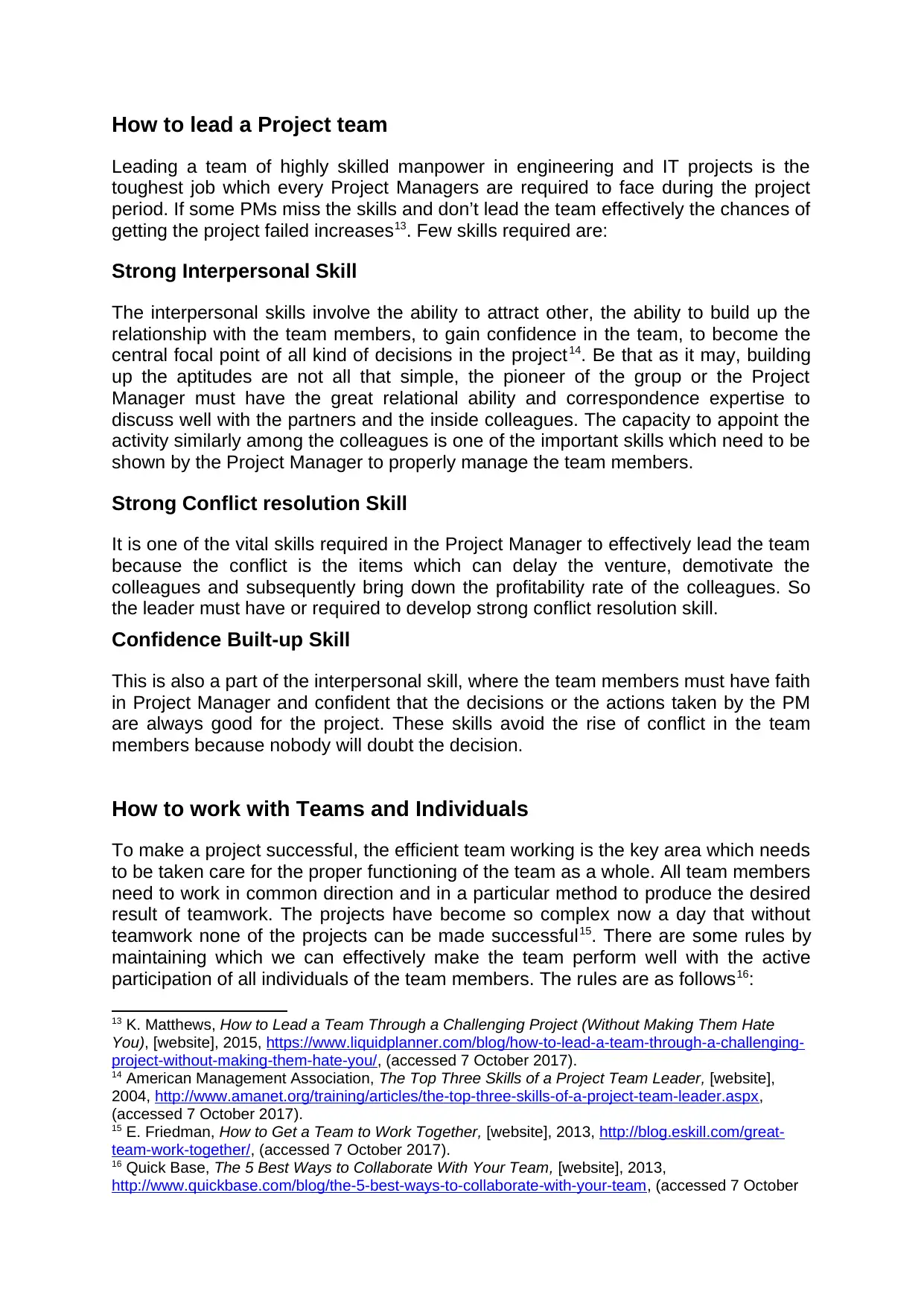
How to lead a Project team
Leading a team of highly skilled manpower in engineering and IT projects is the
toughest job which every Project Managers are required to face during the project
period. If some PMs miss the skills and don’t lead the team effectively the chances of
getting the project failed increases13. Few skills required are:
Strong Interpersonal Skill
The interpersonal skills involve the ability to attract other, the ability to build up the
relationship with the team members, to gain confidence in the team, to become the
central focal point of all kind of decisions in the project14. Be that as it may, building
up the aptitudes are not all that simple, the pioneer of the group or the Project
Manager must have the great relational ability and correspondence expertise to
discuss well with the partners and the inside colleagues. The capacity to appoint the
activity similarly among the colleagues is one of the important skills which need to be
shown by the Project Manager to properly manage the team members.
Strong Conflict resolution Skill
It is one of the vital skills required in the Project Manager to effectively lead the team
because the conflict is the items which can delay the venture, demotivate the
colleagues and subsequently bring down the profitability rate of the colleagues. So
the leader must have or required to develop strong conflict resolution skill.
Confidence Built-up Skill
This is also a part of the interpersonal skill, where the team members must have faith
in Project Manager and confident that the decisions or the actions taken by the PM
are always good for the project. These skills avoid the rise of conflict in the team
members because nobody will doubt the decision.
How to work with Teams and Individuals
To make a project successful, the efficient team working is the key area which needs
to be taken care for the proper functioning of the team as a whole. All team members
need to work in common direction and in a particular method to produce the desired
result of teamwork. The projects have become so complex now a day that without
teamwork none of the projects can be made successful15. There are some rules by
maintaining which we can effectively make the team perform well with the active
participation of all individuals of the team members. The rules are as follows16:
13 K. Matthews, How to Lead a Team Through a Challenging Project (Without Making Them Hate
You), [website], 2015, https://www.liquidplanner.com/blog/how-to-lead-a-team-through-a-challenging-
project-without-making-them-hate-you/, (accessed 7 October 2017).
14 American Management Association, The Top Three Skills of a Project Team Leader, [website],
2004, http://www.amanet.org/training/articles/the-top-three-skills-of-a-project-team-leader.aspx,
(accessed 7 October 2017).
15 E. Friedman, How to Get a Team to Work Together, [website], 2013, http://blog.eskill.com/great-
team-work-together/, (accessed 7 October 2017).
16 Quick Base, The 5 Best Ways to Collaborate With Your Team, [website], 2013,
http://www.quickbase.com/blog/the-5-best-ways-to-collaborate-with-your-team, (accessed 7 October
Leading a team of highly skilled manpower in engineering and IT projects is the
toughest job which every Project Managers are required to face during the project
period. If some PMs miss the skills and don’t lead the team effectively the chances of
getting the project failed increases13. Few skills required are:
Strong Interpersonal Skill
The interpersonal skills involve the ability to attract other, the ability to build up the
relationship with the team members, to gain confidence in the team, to become the
central focal point of all kind of decisions in the project14. Be that as it may, building
up the aptitudes are not all that simple, the pioneer of the group or the Project
Manager must have the great relational ability and correspondence expertise to
discuss well with the partners and the inside colleagues. The capacity to appoint the
activity similarly among the colleagues is one of the important skills which need to be
shown by the Project Manager to properly manage the team members.
Strong Conflict resolution Skill
It is one of the vital skills required in the Project Manager to effectively lead the team
because the conflict is the items which can delay the venture, demotivate the
colleagues and subsequently bring down the profitability rate of the colleagues. So
the leader must have or required to develop strong conflict resolution skill.
Confidence Built-up Skill
This is also a part of the interpersonal skill, where the team members must have faith
in Project Manager and confident that the decisions or the actions taken by the PM
are always good for the project. These skills avoid the rise of conflict in the team
members because nobody will doubt the decision.
How to work with Teams and Individuals
To make a project successful, the efficient team working is the key area which needs
to be taken care for the proper functioning of the team as a whole. All team members
need to work in common direction and in a particular method to produce the desired
result of teamwork. The projects have become so complex now a day that without
teamwork none of the projects can be made successful15. There are some rules by
maintaining which we can effectively make the team perform well with the active
participation of all individuals of the team members. The rules are as follows16:
13 K. Matthews, How to Lead a Team Through a Challenging Project (Without Making Them Hate
You), [website], 2015, https://www.liquidplanner.com/blog/how-to-lead-a-team-through-a-challenging-
project-without-making-them-hate-you/, (accessed 7 October 2017).
14 American Management Association, The Top Three Skills of a Project Team Leader, [website],
2004, http://www.amanet.org/training/articles/the-top-three-skills-of-a-project-team-leader.aspx,
(accessed 7 October 2017).
15 E. Friedman, How to Get a Team to Work Together, [website], 2013, http://blog.eskill.com/great-
team-work-together/, (accessed 7 October 2017).
16 Quick Base, The 5 Best Ways to Collaborate With Your Team, [website], 2013,
http://www.quickbase.com/blog/the-5-best-ways-to-collaborate-with-your-team, (accessed 7 October
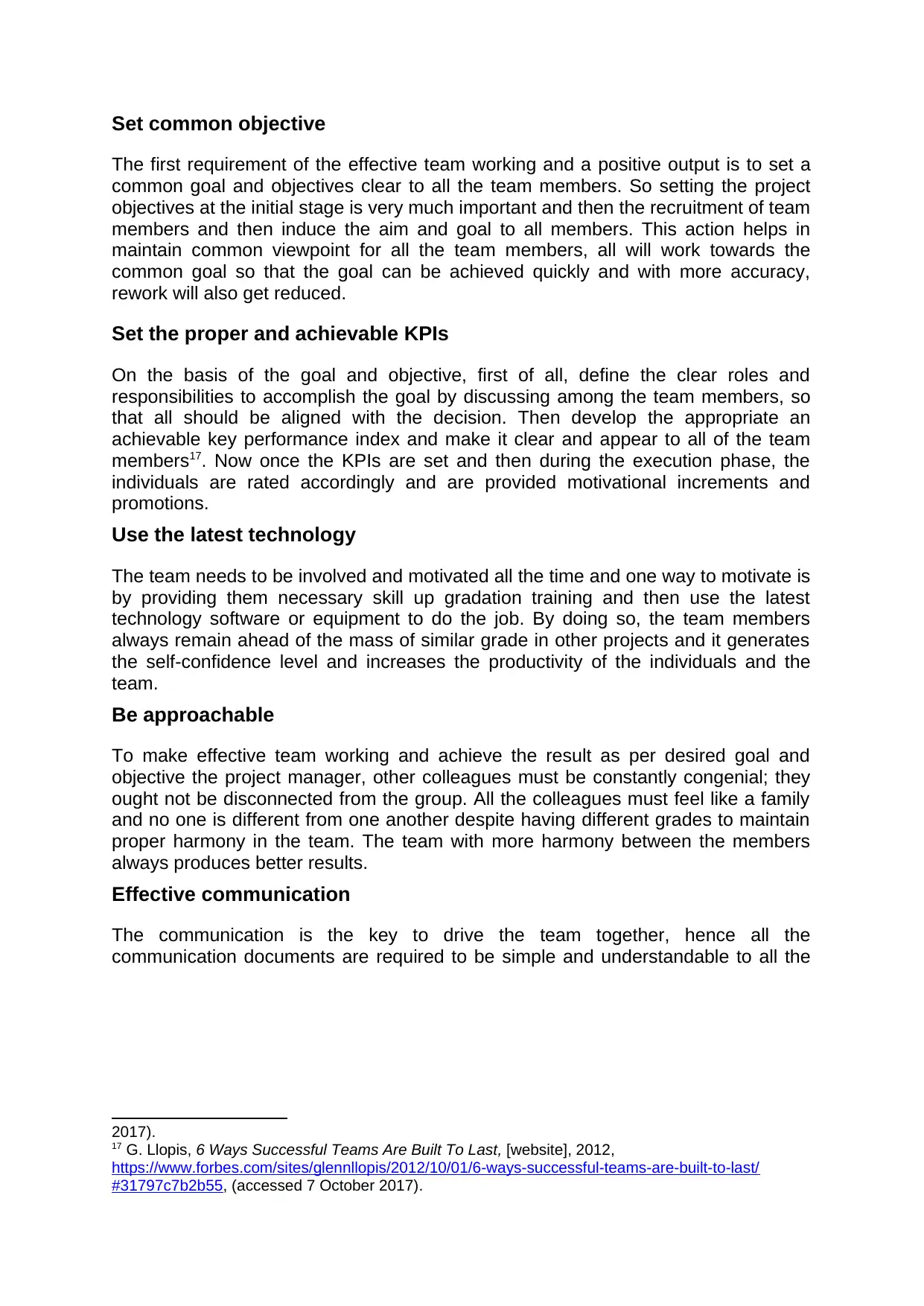
Set common objective
The first requirement of the effective team working and a positive output is to set a
common goal and objectives clear to all the team members. So setting the project
objectives at the initial stage is very much important and then the recruitment of team
members and then induce the aim and goal to all members. This action helps in
maintain common viewpoint for all the team members, all will work towards the
common goal so that the goal can be achieved quickly and with more accuracy,
rework will also get reduced.
Set the proper and achievable KPIs
On the basis of the goal and objective, first of all, define the clear roles and
responsibilities to accomplish the goal by discussing among the team members, so
that all should be aligned with the decision. Then develop the appropriate an
achievable key performance index and make it clear and appear to all of the team
members17. Now once the KPIs are set and then during the execution phase, the
individuals are rated accordingly and are provided motivational increments and
promotions.
Use the latest technology
The team needs to be involved and motivated all the time and one way to motivate is
by providing them necessary skill up gradation training and then use the latest
technology software or equipment to do the job. By doing so, the team members
always remain ahead of the mass of similar grade in other projects and it generates
the self-confidence level and increases the productivity of the individuals and the
team.
Be approachable
To make effective team working and achieve the result as per desired goal and
objective the project manager, other colleagues must be constantly congenial; they
ought not be disconnected from the group. All the colleagues must feel like a family
and no one is different from one another despite having different grades to maintain
proper harmony in the team. The team with more harmony between the members
always produces better results.
Effective communication
The communication is the key to drive the team together, hence all the
communication documents are required to be simple and understandable to all the
2017).
17 G. Llopis, 6 Ways Successful Teams Are Built To Last, [website], 2012,
https://www.forbes.com/sites/glennllopis/2012/10/01/6-ways-successful-teams-are-built-to-last/
#31797c7b2b55, (accessed 7 October 2017).
The first requirement of the effective team working and a positive output is to set a
common goal and objectives clear to all the team members. So setting the project
objectives at the initial stage is very much important and then the recruitment of team
members and then induce the aim and goal to all members. This action helps in
maintain common viewpoint for all the team members, all will work towards the
common goal so that the goal can be achieved quickly and with more accuracy,
rework will also get reduced.
Set the proper and achievable KPIs
On the basis of the goal and objective, first of all, define the clear roles and
responsibilities to accomplish the goal by discussing among the team members, so
that all should be aligned with the decision. Then develop the appropriate an
achievable key performance index and make it clear and appear to all of the team
members17. Now once the KPIs are set and then during the execution phase, the
individuals are rated accordingly and are provided motivational increments and
promotions.
Use the latest technology
The team needs to be involved and motivated all the time and one way to motivate is
by providing them necessary skill up gradation training and then use the latest
technology software or equipment to do the job. By doing so, the team members
always remain ahead of the mass of similar grade in other projects and it generates
the self-confidence level and increases the productivity of the individuals and the
team.
Be approachable
To make effective team working and achieve the result as per desired goal and
objective the project manager, other colleagues must be constantly congenial; they
ought not be disconnected from the group. All the colleagues must feel like a family
and no one is different from one another despite having different grades to maintain
proper harmony in the team. The team with more harmony between the members
always produces better results.
Effective communication
The communication is the key to drive the team together, hence all the
communication documents are required to be simple and understandable to all the
2017).
17 G. Llopis, 6 Ways Successful Teams Are Built To Last, [website], 2012,
https://www.forbes.com/sites/glennllopis/2012/10/01/6-ways-successful-teams-are-built-to-last/
#31797c7b2b55, (accessed 7 October 2017).
Secure Best Marks with AI Grader
Need help grading? Try our AI Grader for instant feedback on your assignments.
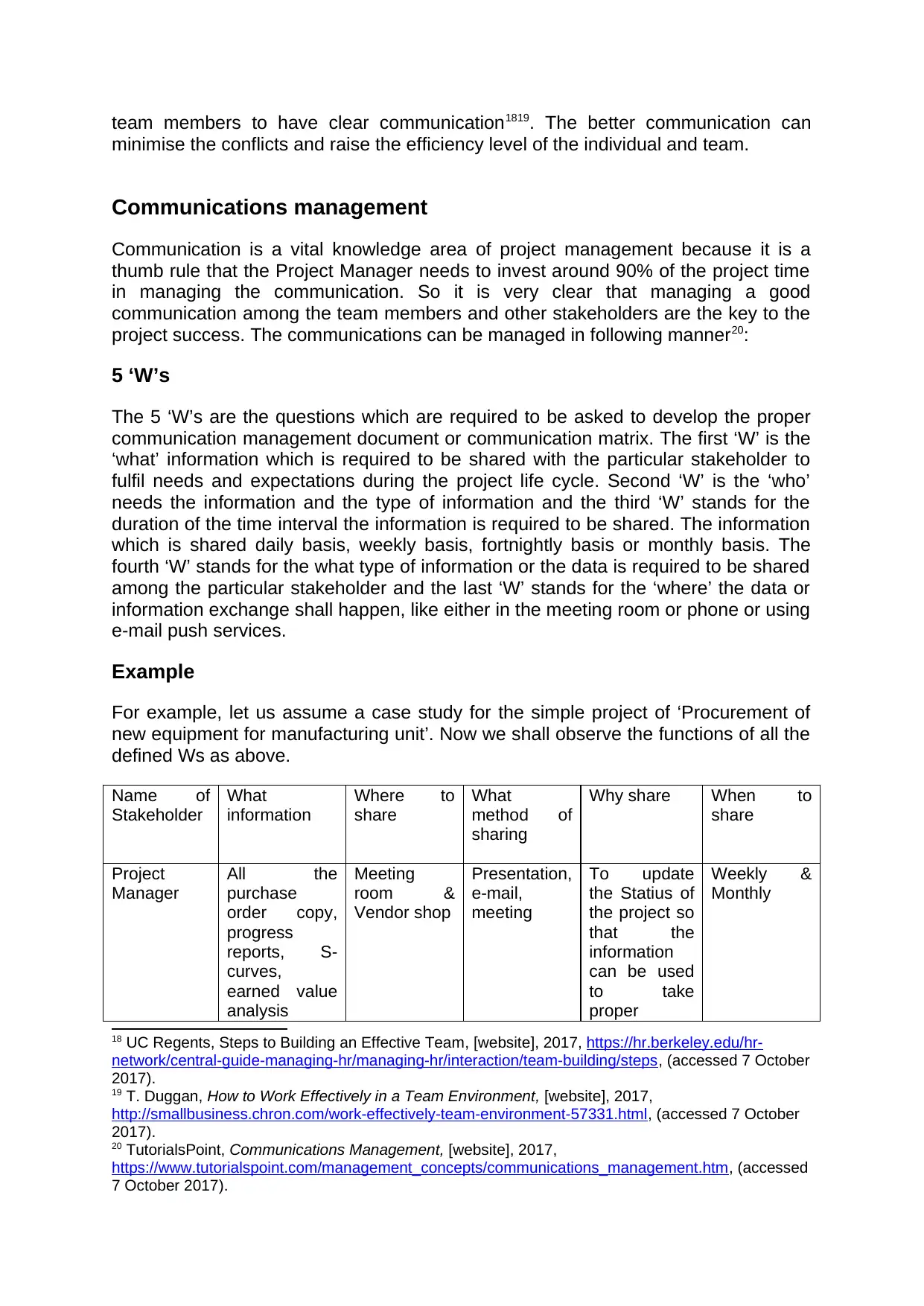
team members to have clear communication1819. The better communication can
minimise the conflicts and raise the efficiency level of the individual and team.
Communications management
Communication is a vital knowledge area of project management because it is a
thumb rule that the Project Manager needs to invest around 90% of the project time
in managing the communication. So it is very clear that managing a good
communication among the team members and other stakeholders are the key to the
project success. The communications can be managed in following manner20:
5 ‘W’s
The 5 ‘W’s are the questions which are required to be asked to develop the proper
communication management document or communication matrix. The first ‘W’ is the
‘what’ information which is required to be shared with the particular stakeholder to
fulfil needs and expectations during the project life cycle. Second ‘W’ is the ‘who’
needs the information and the type of information and the third ‘W’ stands for the
duration of the time interval the information is required to be shared. The information
which is shared daily basis, weekly basis, fortnightly basis or monthly basis. The
fourth ‘W’ stands for the what type of information or the data is required to be shared
among the particular stakeholder and the last ‘W’ stands for the ‘where’ the data or
information exchange shall happen, like either in the meeting room or phone or using
e-mail push services.
Example
For example, let us assume a case study for the simple project of ‘Procurement of
new equipment for manufacturing unit’. Now we shall observe the functions of all the
defined Ws as above.
Name of
Stakeholder
What
information
Where to
share
What
method of
sharing
Why share When to
share
Project
Manager
All the
purchase
order copy,
progress
reports, S-
curves,
earned value
analysis
Meeting
room &
Vendor shop
Presentation,
e-mail,
meeting
To update
the Statius of
the project so
that the
information
can be used
to take
proper
Weekly &
Monthly
18 UC Regents, Steps to Building an Effective Team, [website], 2017, https://hr.berkeley.edu/hr-
network/central-guide-managing-hr/managing-hr/interaction/team-building/steps, (accessed 7 October
2017).
19 T. Duggan, How to Work Effectively in a Team Environment, [website], 2017,
http://smallbusiness.chron.com/work-effectively-team-environment-57331.html, (accessed 7 October
2017).
20 TutorialsPoint, Communications Management, [website], 2017,
https://www.tutorialspoint.com/management_concepts/communications_management.htm, (accessed
7 October 2017).
minimise the conflicts and raise the efficiency level of the individual and team.
Communications management
Communication is a vital knowledge area of project management because it is a
thumb rule that the Project Manager needs to invest around 90% of the project time
in managing the communication. So it is very clear that managing a good
communication among the team members and other stakeholders are the key to the
project success. The communications can be managed in following manner20:
5 ‘W’s
The 5 ‘W’s are the questions which are required to be asked to develop the proper
communication management document or communication matrix. The first ‘W’ is the
‘what’ information which is required to be shared with the particular stakeholder to
fulfil needs and expectations during the project life cycle. Second ‘W’ is the ‘who’
needs the information and the type of information and the third ‘W’ stands for the
duration of the time interval the information is required to be shared. The information
which is shared daily basis, weekly basis, fortnightly basis or monthly basis. The
fourth ‘W’ stands for the what type of information or the data is required to be shared
among the particular stakeholder and the last ‘W’ stands for the ‘where’ the data or
information exchange shall happen, like either in the meeting room or phone or using
e-mail push services.
Example
For example, let us assume a case study for the simple project of ‘Procurement of
new equipment for manufacturing unit’. Now we shall observe the functions of all the
defined Ws as above.
Name of
Stakeholder
What
information
Where to
share
What
method of
sharing
Why share When to
share
Project
Manager
All the
purchase
order copy,
progress
reports, S-
curves,
earned value
analysis
Meeting
room &
Vendor shop
Presentation,
e-mail,
meeting
To update
the Statius of
the project so
that the
information
can be used
to take
proper
Weekly &
Monthly
18 UC Regents, Steps to Building an Effective Team, [website], 2017, https://hr.berkeley.edu/hr-
network/central-guide-managing-hr/managing-hr/interaction/team-building/steps, (accessed 7 October
2017).
19 T. Duggan, How to Work Effectively in a Team Environment, [website], 2017,
http://smallbusiness.chron.com/work-effectively-team-environment-57331.html, (accessed 7 October
2017).
20 TutorialsPoint, Communications Management, [website], 2017,
https://www.tutorialspoint.com/management_concepts/communications_management.htm, (accessed
7 October 2017).
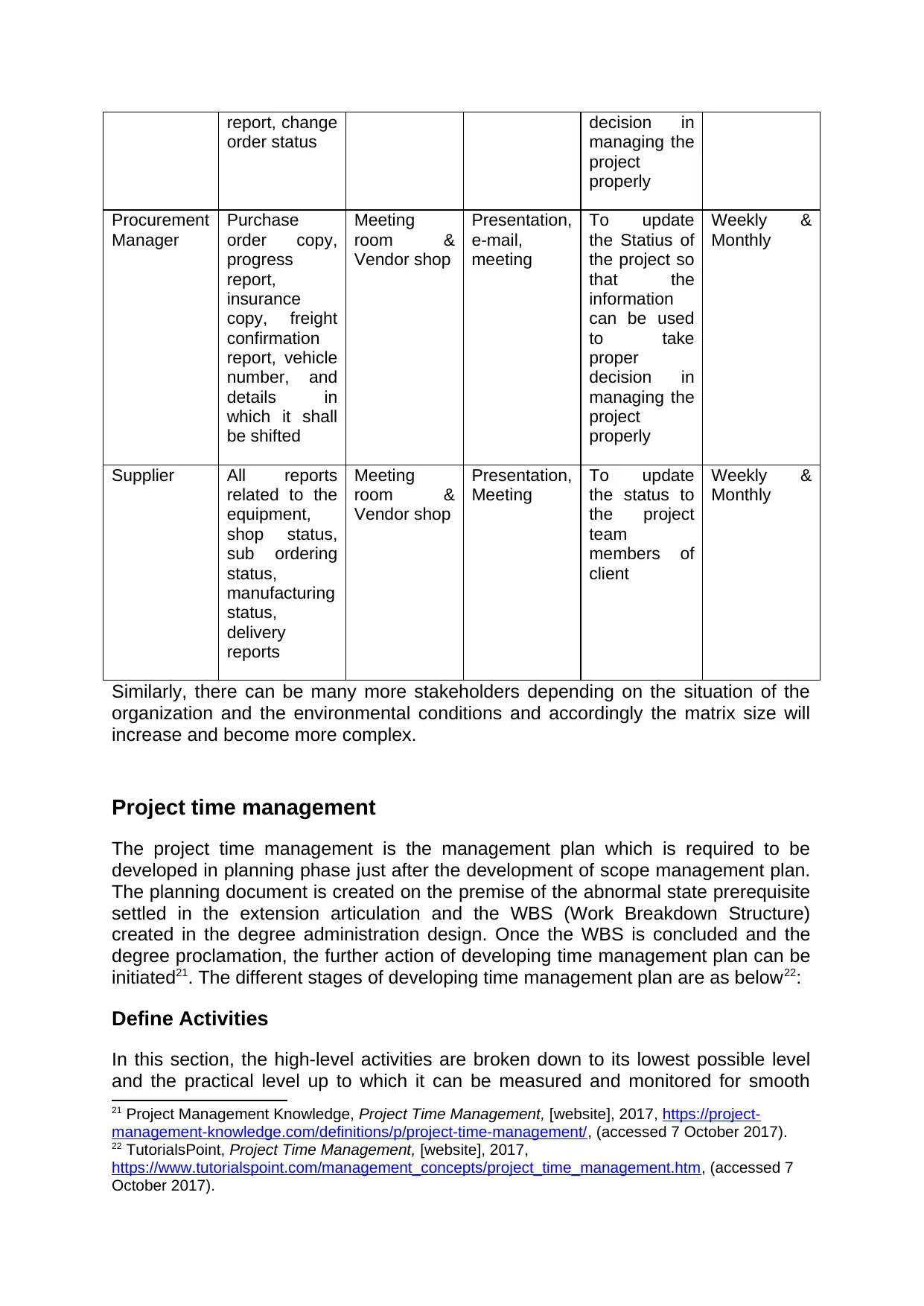
report, change
order status
decision in
managing the
project
properly
Procurement
Manager
Purchase
order copy,
progress
report,
insurance
copy, freight
confirmation
report, vehicle
number, and
details in
which it shall
be shifted
Meeting
room &
Vendor shop
Presentation,
e-mail,
meeting
To update
the Statius of
the project so
that the
information
can be used
to take
proper
decision in
managing the
project
properly
Weekly &
Monthly
Supplier All reports
related to the
equipment,
shop status,
sub ordering
status,
manufacturing
status,
delivery
reports
Meeting
room &
Vendor shop
Presentation,
Meeting
To update
the status to
the project
team
members of
client
Weekly &
Monthly
Similarly, there can be many more stakeholders depending on the situation of the
organization and the environmental conditions and accordingly the matrix size will
increase and become more complex.
Project time management
The project time management is the management plan which is required to be
developed in planning phase just after the development of scope management plan.
The planning document is created on the premise of the abnormal state prerequisite
settled in the extension articulation and the WBS (Work Breakdown Structure)
created in the degree administration design. Once the WBS is concluded and the
degree proclamation, the further action of developing time management plan can be
initiated21. The different stages of developing time management plan are as below22:
Define Activities
In this section, the high-level activities are broken down to its lowest possible level
and the practical level up to which it can be measured and monitored for smooth
21 Project Management Knowledge, Project Time Management, [website], 2017, https://project-
management-knowledge.com/definitions/p/project-time-management/, (accessed 7 October 2017).
22 TutorialsPoint, Project Time Management, [website], 2017,
https://www.tutorialspoint.com/management_concepts/project_time_management.htm, (accessed 7
October 2017).
order status
decision in
managing the
project
properly
Procurement
Manager
Purchase
order copy,
progress
report,
insurance
copy, freight
confirmation
report, vehicle
number, and
details in
which it shall
be shifted
Meeting
room &
Vendor shop
Presentation,
e-mail,
meeting
To update
the Statius of
the project so
that the
information
can be used
to take
proper
decision in
managing the
project
properly
Weekly &
Monthly
Supplier All reports
related to the
equipment,
shop status,
sub ordering
status,
manufacturing
status,
delivery
reports
Meeting
room &
Vendor shop
Presentation,
Meeting
To update
the status to
the project
team
members of
client
Weekly &
Monthly
Similarly, there can be many more stakeholders depending on the situation of the
organization and the environmental conditions and accordingly the matrix size will
increase and become more complex.
Project time management
The project time management is the management plan which is required to be
developed in planning phase just after the development of scope management plan.
The planning document is created on the premise of the abnormal state prerequisite
settled in the extension articulation and the WBS (Work Breakdown Structure)
created in the degree administration design. Once the WBS is concluded and the
degree proclamation, the further action of developing time management plan can be
initiated21. The different stages of developing time management plan are as below22:
Define Activities
In this section, the high-level activities are broken down to its lowest possible level
and the practical level up to which it can be measured and monitored for smooth
21 Project Management Knowledge, Project Time Management, [website], 2017, https://project-
management-knowledge.com/definitions/p/project-time-management/, (accessed 7 October 2017).
22 TutorialsPoint, Project Time Management, [website], 2017,
https://www.tutorialspoint.com/management_concepts/project_time_management.htm, (accessed 7
October 2017).
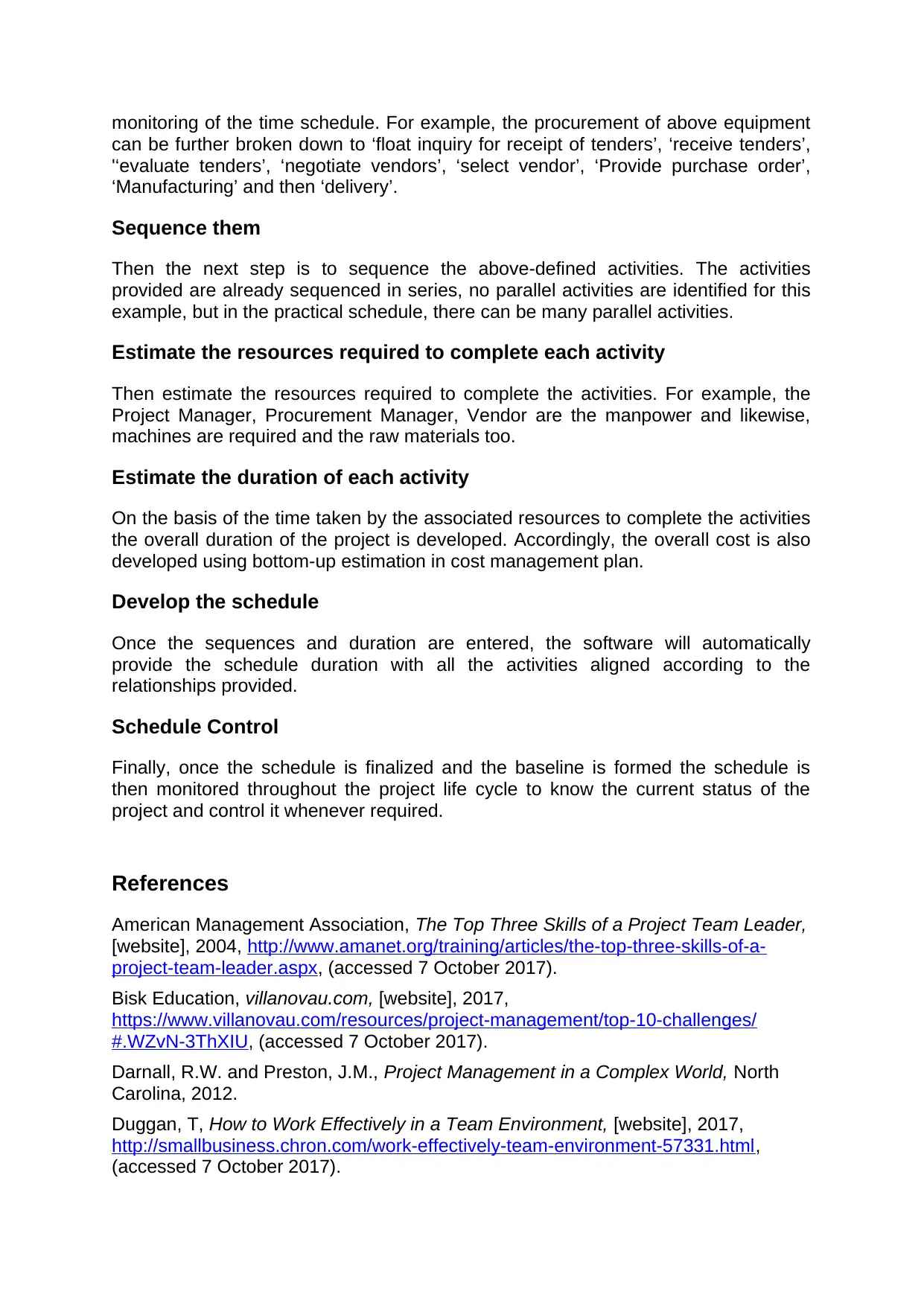
monitoring of the time schedule. For example, the procurement of above equipment
can be further broken down to ‘float inquiry for receipt of tenders’, ‘receive tenders’,
'‘evaluate tenders’, ‘negotiate vendors’, ‘select vendor’, ‘Provide purchase order’,
‘Manufacturing’ and then ‘delivery’.
Sequence them
Then the next step is to sequence the above-defined activities. The activities
provided are already sequenced in series, no parallel activities are identified for this
example, but in the practical schedule, there can be many parallel activities.
Estimate the resources required to complete each activity
Then estimate the resources required to complete the activities. For example, the
Project Manager, Procurement Manager, Vendor are the manpower and likewise,
machines are required and the raw materials too.
Estimate the duration of each activity
On the basis of the time taken by the associated resources to complete the activities
the overall duration of the project is developed. Accordingly, the overall cost is also
developed using bottom-up estimation in cost management plan.
Develop the schedule
Once the sequences and duration are entered, the software will automatically
provide the schedule duration with all the activities aligned according to the
relationships provided.
Schedule Control
Finally, once the schedule is finalized and the baseline is formed the schedule is
then monitored throughout the project life cycle to know the current status of the
project and control it whenever required.
References
American Management Association, The Top Three Skills of a Project Team Leader,
[website], 2004, http://www.amanet.org/training/articles/the-top-three-skills-of-a-
project-team-leader.aspx, (accessed 7 October 2017).
Bisk Education, villanovau.com, [website], 2017,
https://www.villanovau.com/resources/project-management/top-10-challenges/
#.WZvN-3ThXIU, (accessed 7 October 2017).
Darnall, R.W. and Preston, J.M., Project Management in a Complex World, North
Carolina, 2012.
Duggan, T, How to Work Effectively in a Team Environment, [website], 2017,
http://smallbusiness.chron.com/work-effectively-team-environment-57331.html,
(accessed 7 October 2017).
can be further broken down to ‘float inquiry for receipt of tenders’, ‘receive tenders’,
'‘evaluate tenders’, ‘negotiate vendors’, ‘select vendor’, ‘Provide purchase order’,
‘Manufacturing’ and then ‘delivery’.
Sequence them
Then the next step is to sequence the above-defined activities. The activities
provided are already sequenced in series, no parallel activities are identified for this
example, but in the practical schedule, there can be many parallel activities.
Estimate the resources required to complete each activity
Then estimate the resources required to complete the activities. For example, the
Project Manager, Procurement Manager, Vendor are the manpower and likewise,
machines are required and the raw materials too.
Estimate the duration of each activity
On the basis of the time taken by the associated resources to complete the activities
the overall duration of the project is developed. Accordingly, the overall cost is also
developed using bottom-up estimation in cost management plan.
Develop the schedule
Once the sequences and duration are entered, the software will automatically
provide the schedule duration with all the activities aligned according to the
relationships provided.
Schedule Control
Finally, once the schedule is finalized and the baseline is formed the schedule is
then monitored throughout the project life cycle to know the current status of the
project and control it whenever required.
References
American Management Association, The Top Three Skills of a Project Team Leader,
[website], 2004, http://www.amanet.org/training/articles/the-top-three-skills-of-a-
project-team-leader.aspx, (accessed 7 October 2017).
Bisk Education, villanovau.com, [website], 2017,
https://www.villanovau.com/resources/project-management/top-10-challenges/
#.WZvN-3ThXIU, (accessed 7 October 2017).
Darnall, R.W. and Preston, J.M., Project Management in a Complex World, North
Carolina, 2012.
Duggan, T, How to Work Effectively in a Team Environment, [website], 2017,
http://smallbusiness.chron.com/work-effectively-team-environment-57331.html,
(accessed 7 October 2017).
Paraphrase This Document
Need a fresh take? Get an instant paraphrase of this document with our AI Paraphraser
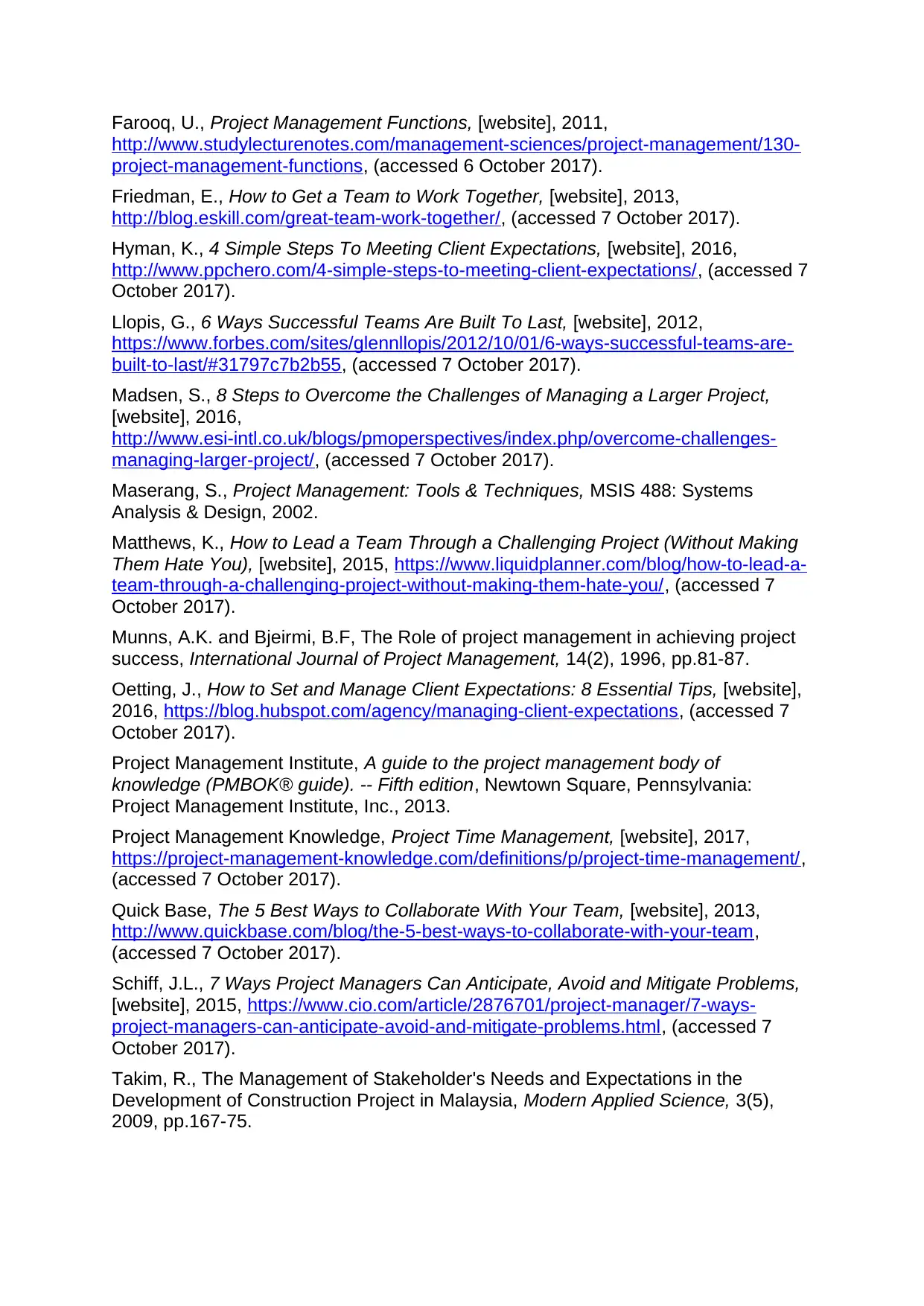
Farooq, U., Project Management Functions, [website], 2011,
http://www.studylecturenotes.com/management-sciences/project-management/130-
project-management-functions, (accessed 6 October 2017).
Friedman, E., How to Get a Team to Work Together, [website], 2013,
http://blog.eskill.com/great-team-work-together/, (accessed 7 October 2017).
Hyman, K., 4 Simple Steps To Meeting Client Expectations, [website], 2016,
http://www.ppchero.com/4-simple-steps-to-meeting-client-expectations/, (accessed 7
October 2017).
Llopis, G., 6 Ways Successful Teams Are Built To Last, [website], 2012,
https://www.forbes.com/sites/glennllopis/2012/10/01/6-ways-successful-teams-are-
built-to-last/#31797c7b2b55, (accessed 7 October 2017).
Madsen, S., 8 Steps to Overcome the Challenges of Managing a Larger Project,
[website], 2016,
http://www.esi-intl.co.uk/blogs/pmoperspectives/index.php/overcome-challenges-
managing-larger-project/, (accessed 7 October 2017).
Maserang, S., Project Management: Tools & Techniques, MSIS 488: Systems
Analysis & Design, 2002.
Matthews, K., How to Lead a Team Through a Challenging Project (Without Making
Them Hate You), [website], 2015, https://www.liquidplanner.com/blog/how-to-lead-a-
team-through-a-challenging-project-without-making-them-hate-you/, (accessed 7
October 2017).
Munns, A.K. and Bjeirmi, B.F, The Role of project management in achieving project
success, International Journal of Project Management, 14(2), 1996, pp.81-87.
Oetting, J., How to Set and Manage Client Expectations: 8 Essential Tips, [website],
2016, https://blog.hubspot.com/agency/managing-client-expectations, (accessed 7
October 2017).
Project Management Institute, A guide to the project management body of
knowledge (PMBOK® guide). -- Fifth edition, Newtown Square, Pennsylvania:
Project Management Institute, Inc., 2013.
Project Management Knowledge, Project Time Management, [website], 2017,
https://project-management-knowledge.com/definitions/p/project-time-management/,
(accessed 7 October 2017).
Quick Base, The 5 Best Ways to Collaborate With Your Team, [website], 2013,
http://www.quickbase.com/blog/the-5-best-ways-to-collaborate-with-your-team,
(accessed 7 October 2017).
Schiff, J.L., 7 Ways Project Managers Can Anticipate, Avoid and Mitigate Problems,
[website], 2015, https://www.cio.com/article/2876701/project-manager/7-ways-
project-managers-can-anticipate-avoid-and-mitigate-problems.html, (accessed 7
October 2017).
Takim, R., The Management of Stakeholder's Needs and Expectations in the
Development of Construction Project in Malaysia, Modern Applied Science, 3(5),
2009, pp.167-75.
http://www.studylecturenotes.com/management-sciences/project-management/130-
project-management-functions, (accessed 6 October 2017).
Friedman, E., How to Get a Team to Work Together, [website], 2013,
http://blog.eskill.com/great-team-work-together/, (accessed 7 October 2017).
Hyman, K., 4 Simple Steps To Meeting Client Expectations, [website], 2016,
http://www.ppchero.com/4-simple-steps-to-meeting-client-expectations/, (accessed 7
October 2017).
Llopis, G., 6 Ways Successful Teams Are Built To Last, [website], 2012,
https://www.forbes.com/sites/glennllopis/2012/10/01/6-ways-successful-teams-are-
built-to-last/#31797c7b2b55, (accessed 7 October 2017).
Madsen, S., 8 Steps to Overcome the Challenges of Managing a Larger Project,
[website], 2016,
http://www.esi-intl.co.uk/blogs/pmoperspectives/index.php/overcome-challenges-
managing-larger-project/, (accessed 7 October 2017).
Maserang, S., Project Management: Tools & Techniques, MSIS 488: Systems
Analysis & Design, 2002.
Matthews, K., How to Lead a Team Through a Challenging Project (Without Making
Them Hate You), [website], 2015, https://www.liquidplanner.com/blog/how-to-lead-a-
team-through-a-challenging-project-without-making-them-hate-you/, (accessed 7
October 2017).
Munns, A.K. and Bjeirmi, B.F, The Role of project management in achieving project
success, International Journal of Project Management, 14(2), 1996, pp.81-87.
Oetting, J., How to Set and Manage Client Expectations: 8 Essential Tips, [website],
2016, https://blog.hubspot.com/agency/managing-client-expectations, (accessed 7
October 2017).
Project Management Institute, A guide to the project management body of
knowledge (PMBOK® guide). -- Fifth edition, Newtown Square, Pennsylvania:
Project Management Institute, Inc., 2013.
Project Management Knowledge, Project Time Management, [website], 2017,
https://project-management-knowledge.com/definitions/p/project-time-management/,
(accessed 7 October 2017).
Quick Base, The 5 Best Ways to Collaborate With Your Team, [website], 2013,
http://www.quickbase.com/blog/the-5-best-ways-to-collaborate-with-your-team,
(accessed 7 October 2017).
Schiff, J.L., 7 Ways Project Managers Can Anticipate, Avoid and Mitigate Problems,
[website], 2015, https://www.cio.com/article/2876701/project-manager/7-ways-
project-managers-can-anticipate-avoid-and-mitigate-problems.html, (accessed 7
October 2017).
Takim, R., The Management of Stakeholder's Needs and Expectations in the
Development of Construction Project in Malaysia, Modern Applied Science, 3(5),
2009, pp.167-75.
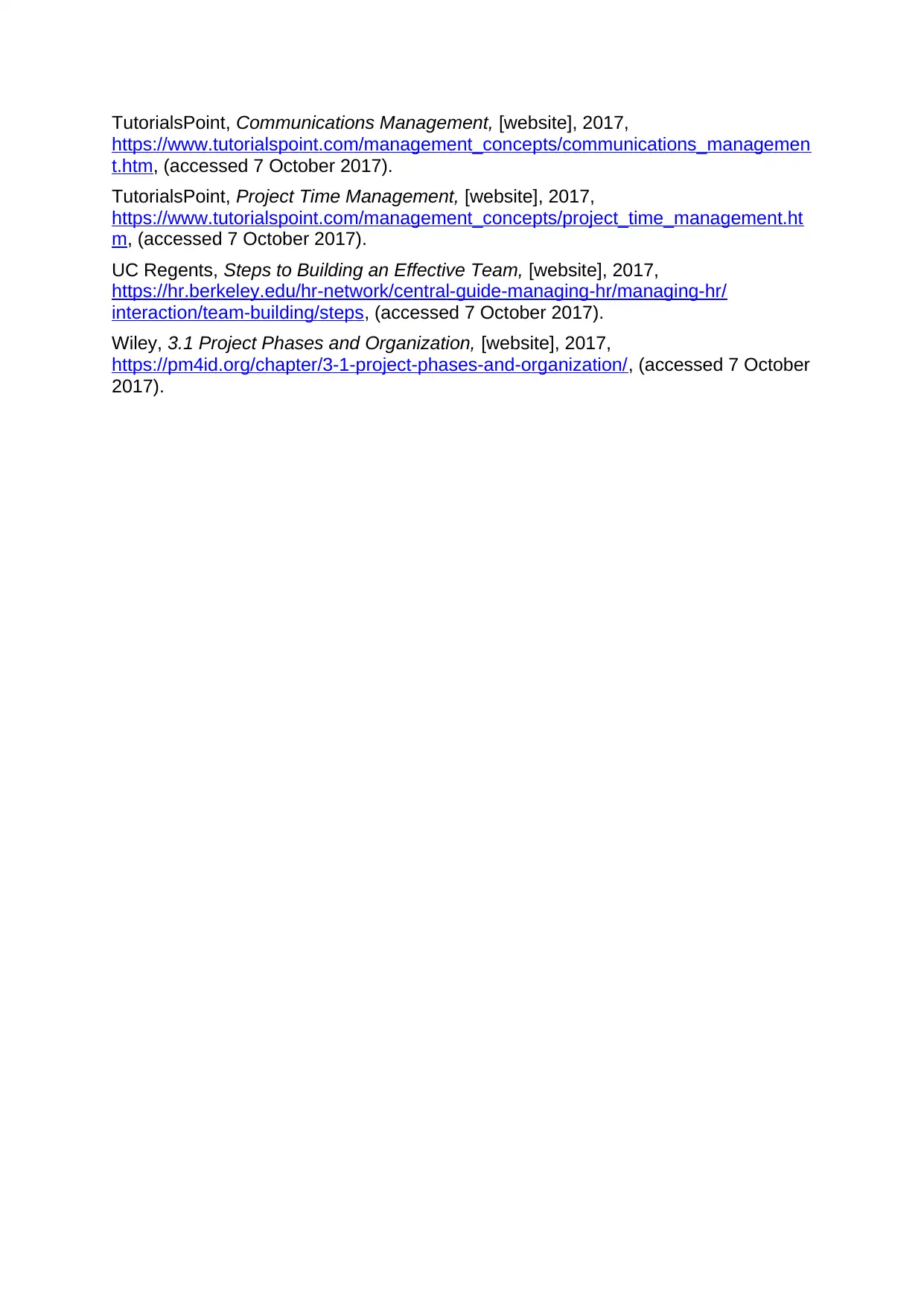
TutorialsPoint, Communications Management, [website], 2017,
https://www.tutorialspoint.com/management_concepts/communications_managemen
t.htm, (accessed 7 October 2017).
TutorialsPoint, Project Time Management, [website], 2017,
https://www.tutorialspoint.com/management_concepts/project_time_management.ht
m, (accessed 7 October 2017).
UC Regents, Steps to Building an Effective Team, [website], 2017,
https://hr.berkeley.edu/hr-network/central-guide-managing-hr/managing-hr/
interaction/team-building/steps, (accessed 7 October 2017).
Wiley, 3.1 Project Phases and Organization, [website], 2017,
https://pm4id.org/chapter/3-1-project-phases-and-organization/, (accessed 7 October
2017).
https://www.tutorialspoint.com/management_concepts/communications_managemen
t.htm, (accessed 7 October 2017).
TutorialsPoint, Project Time Management, [website], 2017,
https://www.tutorialspoint.com/management_concepts/project_time_management.ht
m, (accessed 7 October 2017).
UC Regents, Steps to Building an Effective Team, [website], 2017,
https://hr.berkeley.edu/hr-network/central-guide-managing-hr/managing-hr/
interaction/team-building/steps, (accessed 7 October 2017).
Wiley, 3.1 Project Phases and Organization, [website], 2017,
https://pm4id.org/chapter/3-1-project-phases-and-organization/, (accessed 7 October
2017).
1 out of 15
Related Documents
Your All-in-One AI-Powered Toolkit for Academic Success.
+13062052269
info@desklib.com
Available 24*7 on WhatsApp / Email
![[object Object]](/_next/static/media/star-bottom.7253800d.svg)
Unlock your academic potential
© 2024 | Zucol Services PVT LTD | All rights reserved.




